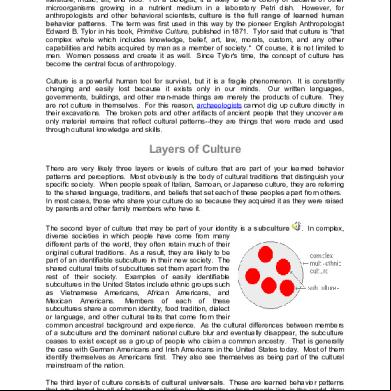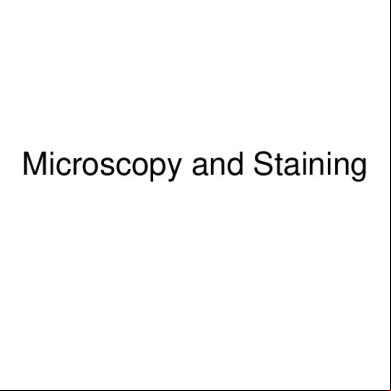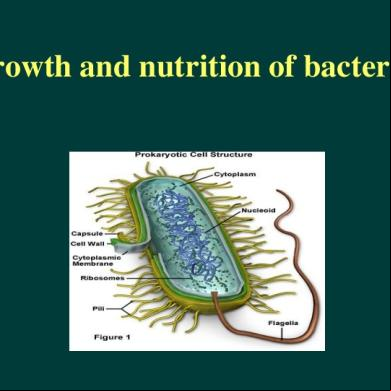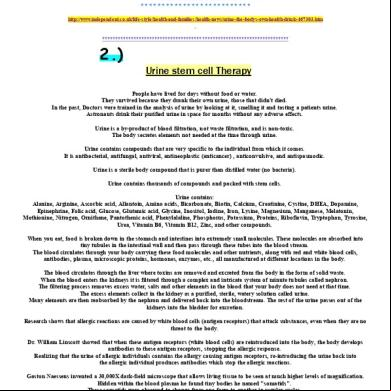Culture Methods 631t6i
This document was ed by and they confirmed that they have the permission to share it. If you are author or own the copyright of this book, please report to us by using this report form. Report 2z6p3t
Overview 5o1f4z
& View Culture Methods as PDF for free.
More details 6z3438
- Words: 1,085
- Pages: 26
Culture methods The indications for culture are : 1) isolate bacteria in pure culture 2) demonstrate their properties 3) preparation of antigens & other tests 4) type isolates by bacteriophage & bacteriocin susceptibility 5) sensitivity to antibiotics 6) estimate viable counts 7) maintain stock cultures
Methods Streak, lawn, stroke, stab, pour plate & liquid cultures Special method for anaerobic bacteria
Sweep plate method for bacteria in the dust on clothing
Streak culture (surface plating) Routinely employed A platinum loop (high cost) or nichrome resistance wire charged with the specimen A loopful transferred to the periphery of a well dried plate
Streak culture
contd…
Distributed thinly by streaking parallel lines Then to different segments of the plate The loop should be flamed & cooled between the different sets of streaks Incubation Growth confluent at the original inoculation Well separated colonies over the final streak
The lawn or carpet culture Provides a uniform surface growth Useful for phage typing & antibiotic sensitivity testing (disc method) To prepare bacterial antigens & vaccines Prepared by flooding the surface with a liquid culture Pipetted off the excess inoculum Incubate Inoculation by a swab soaked in bacterial suspension-alternate method
Lawn or carpet culture
Stroke culture Made in tubes containing agar slope Employed for providing pure growth for slide agglutination & other diagnostic tests
Stab culture Medium punctured with a long ,straight charged wire Employed for demonstration of gelatin liquefaction & oxygen requirement To maintain stock cultures
Pour plate culture Tubes containing 15 ml of the agar Melted & left to cool in water bath at 45 – 50 c Appropriate dilutions of the inoculum are added in 1 ml volume to the molten agar Mixed well & poured into a sterile petridish Allowed to set & incubate Colonies enumerated using colony counters Gives an estimation of viable bacterial count in a suspension Recommended method for quantitative urine cultures
Pour plate method
Sweep plate method Edges of the petridishes containing the medium are rubbed over the fabric Colonies develop on incubation Counted & estimates made
Liquid cultures Made by touching with a charged loop in a broth Large inocula can be employed Method adopted for blood culture & for sterility tests – concentration of bacteria are small Used for inocula containing antibiotics & other antibacterial substances – rendered ineffective by dilution in the medium Preferred when large yields are desired Disadvantage, does not provide a pure culture from mixed inocula.
Anaerobic culture methods Principles : 1.exclusion of oxygen or production of a vacuum 2.displacement of oxygen with other gases 3.absorption of oxygen by chemical or biological means 4.reduction of oxygen
Cultivation in vacuum Inoculating cultures in a vacuum desiccator Unsatisfactory as some oxygen always remains behind Fluid cultures may boil over The media may get detached from the plates Not in use now
Displacement of oxygen with gases H2, N2, helium or CO2 Popular but ineffective method is candle jar Inoculated plates placed in a airtight container Lighted candle kept & the lid sealed Lighted candle expected to use oxygen But some always left behind Candle jar provides CO2 which stimulates the growth of most bacteria
Candle jar
Chemical methods Alkaline pyragallol absorbs oxygen Pyrogallic acid added to NAOH in a test tube Placed inside an airtight jar Disadvantage – small amount of CO formed inhibitory to some bacteria Mixture of chromium & sulphuric acid (Rosenthal method) Mixture of chromium & yellow phosphorous
Mc Intosh & Fildes jar stout glass or metal jar with a metal lid
Clamped airtight with screw Lid has 2 tubes with taps One act as the gas inlet,other as the outlet 2 terminals to connect electrical supply Underside of the terminals of the lid a small grooved porcelain spool A palledinised asbestos wraps around it Inoculated plates placed inside the jar Outlet tube connected to vacuum pump & air inside evacuated
Mc Intosh & Fildes jar
Mc Intosh contd…… The outlet tap closed The inlet tube connected to a H2 supply & fill with it Terminals are connected to a current supply Heated asbestos acts as a catalyst,combination of H2 with the residual O2 Risk of explosion but rare eliminated by alumina pellets coated with palladium,contained in a gauze sachet act as catalyst at room temperature
Gas pack Method of choice Disposable envelop has chemicals,generates H2 & CO2 on the addition of water Inoculated plates are kept in the jar with the envelop Water added The lid screwed tight Simple & effective Indicator - reduced methylene blue,colorless anaerobically
Biological methods Incubation along with aerobic bacteria, germinating seeds or chopped vegetables Anaerobiosis is slow & ineffective with biological methods
Reduction of oxygen Various reducing agents – 1% glucose, 1% thyoglycolate, 0.1% ascorbic acid & 0.05% cysteine Pieces of red hot iron in broth – easy method Broth containing many animal tissue s the growth of anaerobes Robertson’s cooked meat medium is most widely used, consists of fat free minced cooked meat in broth Even strict anaerobes grow Indicates saccharolytic activity – red Proteolytic activity - black
Glove box Air-tight, glassfronted cabinet filled with inert gas An entry lock for the introduction & removal of materials Gloves for the insertion of hands for working
Methods of isolating pure cultures 1. Surface plating 2. Enrichment, selective & indicator media for the isolation of of pathogens from specimens like feces 3. Pretreatment of specimens with bactericidal substances which destroy unwanted bacteria E.g :isolation of T.B bacilli from sputum by treatment with alkali 4. Obligate aerobes & anaerobes,cultivation under aerobic & anaerobic conditions 5. Separation of bacteria with different temperature optima E.g :only thermophiles grow at 60c
Pure culture contd…. 6. By heating at 80 c vegetative forms can be
eliminated E.g : isolation of tetanus bacilli from dust 7. Separation of motile & nonmotile bacteria by Craigie’s tube.Motile traverse & appear at the top of medium 8. Inoculation into animals, pathogens produce fatal septicemia.Cultured pure from the heart blood 9. By using selective filters 10.Use of micromanipulators by which a single bacterium can be separated
Methods Streak, lawn, stroke, stab, pour plate & liquid cultures Special method for anaerobic bacteria
Sweep plate method for bacteria in the dust on clothing
Streak culture (surface plating) Routinely employed A platinum loop (high cost) or nichrome resistance wire charged with the specimen A loopful transferred to the periphery of a well dried plate
Streak culture
contd…
Distributed thinly by streaking parallel lines Then to different segments of the plate The loop should be flamed & cooled between the different sets of streaks Incubation Growth confluent at the original inoculation Well separated colonies over the final streak
The lawn or carpet culture Provides a uniform surface growth Useful for phage typing & antibiotic sensitivity testing (disc method) To prepare bacterial antigens & vaccines Prepared by flooding the surface with a liquid culture Pipetted off the excess inoculum Incubate Inoculation by a swab soaked in bacterial suspension-alternate method
Lawn or carpet culture
Stroke culture Made in tubes containing agar slope Employed for providing pure growth for slide agglutination & other diagnostic tests
Stab culture Medium punctured with a long ,straight charged wire Employed for demonstration of gelatin liquefaction & oxygen requirement To maintain stock cultures
Pour plate culture Tubes containing 15 ml of the agar Melted & left to cool in water bath at 45 – 50 c Appropriate dilutions of the inoculum are added in 1 ml volume to the molten agar Mixed well & poured into a sterile petridish Allowed to set & incubate Colonies enumerated using colony counters Gives an estimation of viable bacterial count in a suspension Recommended method for quantitative urine cultures
Pour plate method
Sweep plate method Edges of the petridishes containing the medium are rubbed over the fabric Colonies develop on incubation Counted & estimates made
Liquid cultures Made by touching with a charged loop in a broth Large inocula can be employed Method adopted for blood culture & for sterility tests – concentration of bacteria are small Used for inocula containing antibiotics & other antibacterial substances – rendered ineffective by dilution in the medium Preferred when large yields are desired Disadvantage, does not provide a pure culture from mixed inocula.
Anaerobic culture methods Principles : 1.exclusion of oxygen or production of a vacuum 2.displacement of oxygen with other gases 3.absorption of oxygen by chemical or biological means 4.reduction of oxygen
Cultivation in vacuum Inoculating cultures in a vacuum desiccator Unsatisfactory as some oxygen always remains behind Fluid cultures may boil over The media may get detached from the plates Not in use now
Displacement of oxygen with gases H2, N2, helium or CO2 Popular but ineffective method is candle jar Inoculated plates placed in a airtight container Lighted candle kept & the lid sealed Lighted candle expected to use oxygen But some always left behind Candle jar provides CO2 which stimulates the growth of most bacteria
Candle jar
Chemical methods Alkaline pyragallol absorbs oxygen Pyrogallic acid added to NAOH in a test tube Placed inside an airtight jar Disadvantage – small amount of CO formed inhibitory to some bacteria Mixture of chromium & sulphuric acid (Rosenthal method) Mixture of chromium & yellow phosphorous
Mc Intosh & Fildes jar stout glass or metal jar with a metal lid
Clamped airtight with screw Lid has 2 tubes with taps One act as the gas inlet,other as the outlet 2 terminals to connect electrical supply Underside of the terminals of the lid a small grooved porcelain spool A palledinised asbestos wraps around it Inoculated plates placed inside the jar Outlet tube connected to vacuum pump & air inside evacuated
Mc Intosh & Fildes jar
Mc Intosh contd…… The outlet tap closed The inlet tube connected to a H2 supply & fill with it Terminals are connected to a current supply Heated asbestos acts as a catalyst,combination of H2 with the residual O2 Risk of explosion but rare eliminated by alumina pellets coated with palladium,contained in a gauze sachet act as catalyst at room temperature
Gas pack Method of choice Disposable envelop has chemicals,generates H2 & CO2 on the addition of water Inoculated plates are kept in the jar with the envelop Water added The lid screwed tight Simple & effective Indicator - reduced methylene blue,colorless anaerobically
Biological methods Incubation along with aerobic bacteria, germinating seeds or chopped vegetables Anaerobiosis is slow & ineffective with biological methods
Reduction of oxygen Various reducing agents – 1% glucose, 1% thyoglycolate, 0.1% ascorbic acid & 0.05% cysteine Pieces of red hot iron in broth – easy method Broth containing many animal tissue s the growth of anaerobes Robertson’s cooked meat medium is most widely used, consists of fat free minced cooked meat in broth Even strict anaerobes grow Indicates saccharolytic activity – red Proteolytic activity - black
Glove box Air-tight, glassfronted cabinet filled with inert gas An entry lock for the introduction & removal of materials Gloves for the insertion of hands for working
Methods of isolating pure cultures 1. Surface plating 2. Enrichment, selective & indicator media for the isolation of of pathogens from specimens like feces 3. Pretreatment of specimens with bactericidal substances which destroy unwanted bacteria E.g :isolation of T.B bacilli from sputum by treatment with alkali 4. Obligate aerobes & anaerobes,cultivation under aerobic & anaerobic conditions 5. Separation of bacteria with different temperature optima E.g :only thermophiles grow at 60c
Pure culture contd…. 6. By heating at 80 c vegetative forms can be
eliminated E.g : isolation of tetanus bacilli from dust 7. Separation of motile & nonmotile bacteria by Craigie’s tube.Motile traverse & appear at the top of medium 8. Inoculation into animals, pathogens produce fatal septicemia.Cultured pure from the heart blood 9. By using selective filters 10.Use of micromanipulators by which a single bacterium can be separated










